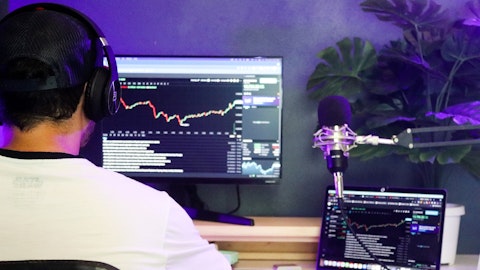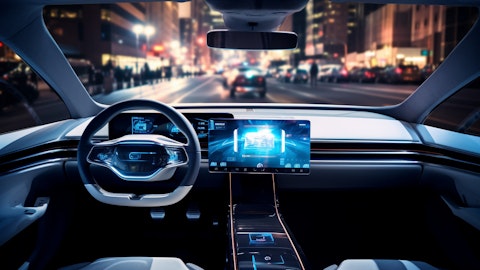Justine Laufer: Great. Thank you. And one other question related to Continental. So I’m just wondering how the progress on development of a fallback system with Continental is going, kind of like what does the progress look like? What’s the timeline for completing that development?
Chris Urmson: Yeah. So we can’t get into too much details, obviously, given the prior nature of the relationship, but it’s moving along. We internally have a series of milestone gates that we move through with them and the team is making great progress towards them. We are still working towards that 2027 launch of the hardware kits and we’re excited about the progress we’re making.
Justine Laufer: Great. Thank you.
Chris Urmson: Yeah.
David Maday: Yeah. I think the other thing to point out in here is that we have — again, it’s a new fallback system. We have an existing fallback system and that’s going to be the default if this one ends up — if we have any potential issues and things like that where it’s a little bit delayed. So it’s not going to prohibit our overall launch, but this is where we intend to go and the progress thus far is going very well. But we’re not going to be bound by that in terms of introducing our new hardware solutions.
Chris Urmson: We have a fallback for a fallback system, so to speak.
Operator: Thank you. [Operator Instructions] Our next question comes from Mark Delaney with Goldman Sachs. Please state your question.
Mark Delaney: Yes. Good afternoon. Thanks very much for taking my questions. I guess, first, now that you have some contracts in place, can you share any details or context on what margins and cash flow may do compared to the current baseline as the company starts its Commercial Launch at the end of 2024 and ramps in 2025?
David Maday: Yeah. Hey, Mark. How are you doing? And I think, right now, obviously, these are all commitments that are confidential, so I can’t really share any of the details on them. I can tell you that we are — we’ve been fairly consistent about pricing this product similar to what the market has overall in terms of like a price per mile and it varies by the lanes that we operate in, and so we have a consistent framework with that for our contracts that we’re signing today. The other thing, in terms of like a margin basis, like, we’re going to still, as we’ve said before, we’re starting out with up to a fleet of 20 vehicles, so it’s going to be pretty modest right when we first launch and so you’re not going to see a substantial amount of change in terms of the revenue. We’re going to provide a little bit more context at Analyst Day, our Investor Analyst Day, coming up in March in terms of how to think about this on a forward looking basis.
Mark Delaney: Well, I’ll stay tuned for more details on that one in March and thanks for the color you’re able to share. My other question was around closing the software Safety Case. I think the company had a target to complete the software Safety Case and do that around the end of 1Q 2024. I apologize if I missed it, but are you able to share an update on when you plan to complete that? Thanks.
Chris Urmson: Yeah. No. Great question. So we’ve been making really strong progress in that and it’s reflected where, if you look at, we’re about 93% closed of the Safety Case. When we set the roadmap for the company about 18 months ago, we laid out three major milestones to get the feature complete, where all the parts were in place, to get to Aurora Driver Ready, where we had closed the — we convinced ourselves that the parts that Aurora controlled were safe and then get to Commercial Launch, where we are then taking the Safety Case for our system, integrating with the vehicle and getting it on the road serving customers. As we’ve made the progress through that, we expected to get to about 95%. At the end of the year, we ended up at about 93% at the end of January or mid-January.
As we look forward for this year, we’ve come to the conclusion that the right step forward for us is, instead of sequencing these sequentially, is to be working on them in parallel. And we talked last time about how we began moving some of our resources off of the closing the Safety Case and working on the next generation work and expanding the performance of the system as it moves past Safety Case closed. You can think of this as the continuous improvement, so that we’re — at this point, we’re really focused on how do we get the quality and performance of the product to a point where it’s going to deliver for our customers in the ways that they need it to.
Mark Delaney: Understood. Thank you.
Operator: Our next question comes from Andres Sheppard with Cantor Fitzgerald. Please state your question.
Andres Sheppard: Hi. Good afternoon and thanks for taking our question, and congrats on the quarter and all of the recent developments. I guess, our first question is, how should we think about future routes following the Sunbelt, trying to get a sense, maybe at a high level, medium to longer term? What are some target routes that would make sense in addition to what you have currently targeting? Thank you.
Chris Urmson: I’m happy to start and then we’ll hand over to Dave to add a little more color. So as we think about it, it’s very much going to be driven by demand. Once we kind of unlock the initial routes, as we’ve talked about, we see small incremental work for whatever the new feature is that’s on lanes that we go to after that. We’ve talked about between Fort Worth and El Paso, the big difference is we have to be able to drive down a hill and we have to be able to deal with a customer border patrol station and we do both those things today and we need to expand, we’ll need to validate that work. As we move to other lanes, it’ll be, okay, there’s a — whatever the new thing is, if there is anything that we have to add.





